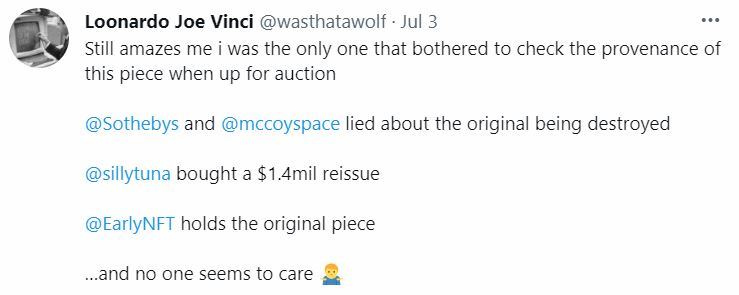This is a follow-up to my post where I argued that Kevin McCoy’s pre-NFT experiment, however brilliant, was not a real NFT.
More information has surfaced which proves my point.

It took me a while to verify this claim. The artwork was originally recorded on the Namecoin blockchain but there are not that many Namecoin explorers out there. They are not easy to make sense of either.
I did eventually figure out that in 2014 McCoy recorded the title of Quantum under the rather cryptic name d41b8540cbacdf1467cdc5d17316dcb672c8b43235fa16cde98e79825b68709a.
View the original record on Tokenview and its entire history on Namebrow.
This record stayed inactive from 2014 until 2021. It means it expired sometime in 2014 or ’15. This is due to a feature of Namecoin where a fee must be paid periodically to keep a name active. If you forget to renew, or simply don’t want to pay, the name expires and is free for anyone to re-register.
In April 2021 it was again registered, and this must obviously have been by @EarlyNFT. With it he may just have received the ownership of a million dollar artwork.
You see, in 2014 Kevin McCoy promised the ownership to whoever controlled this Namecoin record. He wrote; I assert title to the file at the URL http://static.mccoyspace.com/gifs/quantum.gif with the creator’s public announcement of it’s publishing at the URL https://twitter.com/mccoyspace/status/462320426719641600 The file whose SHA256 hash is d41b8540cbacdf1467cdc5d17316dcb672c8b43235fa16cde98e79825b68709a is taken to be the file in question. Title transfers to whoever controls this blockchain entry.
From the above logic it seems clear to me that @EarlyNFT owns the copyright, and – for all I know – he could even sue McCoy and Sotherby’s for auctioning off an Ethereum token which claimed to include ownership of his artwork without his consent.
Kevin McCoy’s Case
I raise some questions which may support McCoy.
- Was the blockchain text legally binding?
- The record expired in 2014/15. Does the new 2021 registration with the same name constitute a continuation of the old blockchain entry?
- Can “controls this blockchain entry” mean the original address from which it was published?
Before creating the Ethereum replica, McCoy did verify ownership of the old address through a signed message:

Surprisingly, on 7 June 2021 the Namecoin entity controlled by @EarlyNFT made this update: **An authorized print of this original NFT, entitled “Quantum” by Kevin McCoy, is currently being auctioned off by Sotheby’s. Good Luck to all the bidders.**
To me at least, the phrasing authorized print implies an endorsement of the auction of McCoy’s newly minted Ethereum token. This also includes transfer of ownership. Within the auction‘s supporting documents you will find the Quantum Rights Agreement, and clause 3.4 states that Ownership of this artwork rests with whomever controls this blockchain entry.
On 10 June 2021 the token was sold at Sotheby’s for $1,420,000 to @sillytuna.
On 14 June 2021, i.e. after Quantum’s ownership is sold, @EarlyNFT seems to have changed his mind; **This original NFT, entitled “Quantum” by Kevin McCoy and minted on May 2, 2014, is currently held by the person who controls the Twitter handle @EarlyNFT. Please direct message all inquires about the artwork there.**
The Public Domain Case
One could argue that since the blockchain entry expired, it no longer belongs to anyone, hence is public domain. This is based on the understanding that the re-registration became a separate new blockchain entry.
My Verdict
I don’t know who is right. I’m bamboozled by it all. It would be an interesting legal case though.
What I can say with certainty is that the 2014 blockchain entry was not an NFT. McCoy implicitly admitted this when he in 2021 claimed ownership, not by controlling his so-called NFT. but by signing a message from the issuing address instead.
Categories: Uncategorized